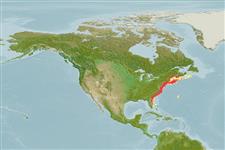Environment: milieu / climate zone / depth range / distribution range
Écologie
marin; saumâtre démersal; océanodrome; profondeur 10 - 183 m (Ref. 5951), usually ? - 37 m (Ref. 5951). Temperate; 45°N - 25°N, 81°W - 57°W
Northwest Atlantic: Maine (rarely Nova Scotia, Canada) to southern Florida, USA.
Length at first maturity / Taille / Poids / Âge
Maturity: Lm 28.0 range ? - ? cm
Max length : 94.0 cm TL mâle / non sexé; (Ref. 7251); poids max. publié: 12.0 kg (Ref. 7251); âge max. reporté: 9 années (Ref. 52684)
Adults usually prefer hard sandy substrate where they can burrow; can exploit a broad range of lower and mid-estuary habitats including salt marsh creeks and seagrass beds, which usually have muddy or silty substrates , as well as sand flats (Ref. 26621). Occur in bays, lagoons and shallow coastal waters. Utilized fresh and frozen; can be steamed, fried, boiled, microwaved and baked (Ref. 9988). Exported fresh to Japan for sashimi.
Distinct pairing (Ref. 205).
Robins, C.R. and G.C. Ray, 1986. A field guide to Atlantic coast fishes of North America. Houghton Mifflin Company, Boston, U.S.A. 354 p. (Ref. 7251)
Statut dans la liste rouge de l'IUCN (Ref. 130435: Version 2024-2)
Menace pour l'homme
Other
Utilisations par l'homme
Pêcheries: commercial; pêche sportive: oui
Outils
Articles particuliers
Télécharger en XML
Sources Internet
Estimates based on models
Preferred temperature (Ref.
123201): 9.1 - 24.4, mean 19.1 °C (based on 12 cells).
Phylogenetic diversity index (Ref.
82804): PD
50 = 0.5000 [Uniqueness, from 0.5 = low to 2.0 = high].
Bayesian length-weight: a=0.00589 (0.00465 - 0.00745), b=3.17 (3.12 - 3.22), in cm total length, based on LWR estimates for this species (Ref.
93245).
Niveau trophique (Ref.
69278): 4.5 ±0.3 se; based on diet studies.
Generation time: 5.1 ( na - na) years. Estimated as median ln(3)/K based on 1
growth studies.
Résilience (Ref.
120179): Milieu, temps minimum de doublement de population : 1,4 à 4,4 années (K=0.77-0.84(?); assuming tm>=2; tmax=9).
Prior r = 0.86, 95% CL = 0.57 - 1.30, Based on 1 full stock assessment.
Fishing Vulnerability (Ref.
59153): Moderate to high vulnerability (47 of 100).
Climate Vulnerability (Ref.
125649): Moderate to high vulnerability (51 of 100).
Nutrients (Ref.
124155): Calcium = 25.9 [11.3, 42.8] mg/100g; Iron = 0.292 [0.145, 0.532] mg/100g; Protein = 16.5 [14.1, 19.7] %; Omega3 = 0.374 [0.200, 0.700] g/100g; Selenium = 16.3 [8.0, 35.8] μg/100g; VitaminA = 9.6 [2.5, 41.5] μg/100g; Zinc = 0.321 [0.219, 0.478] mg/100g (wet weight);
